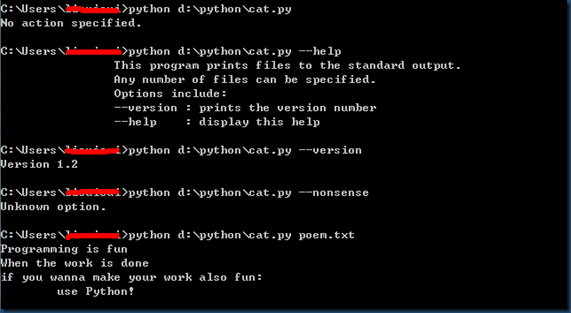第14章 python 标准库
Python标准库是随Python附带安装的,它包含大量极其有用的模块。
sys 模块
sys 模块包含系统对应的功能。如 sys.argv 列表包含命令行参数。
# -*- coding: utf-8 -*- # Filename: cat.py import sys def readfile(filename): '''print a file to the standard output.''' f = file(filename) while True: line = f.readline() if len(line) == 0: break print line, # notice comma f.close() # script starts from here if len(sys.argv) < 2: print 'No action specified.' sys.exit() if sys.argv[1].startswith('--'): option = sys.argv[1][2:] # fetch sys.argv[1] but without the first two characters if option == 'version': print 'Version 1.2' elif option == 'help': print ''' This program prints files to the standard output. Any number of files can be specified. Options include: --version : prints the version number --help : display this help''' else: print 'Unknown option.' sys.exit() else: for filename in sys.argv[1:]: readfile(filename)
os 模块
该模块包含普遍的操作系统功能。如果你希望你的程序能够与平台无关的话,这个模块是尤为重要的。即它允许一个程序在编写后不需要任何改动,也不会发生任何问题,就可以在Linux和Windows下运行。一个例子就是使用 os.sep 可以取代操作系统特定的路径分割符。
下面列出了一些在os模块中比较有用的部分。
- os.name 字符串指示你正在使用的平台。比如对于 Windows,它是 'nt',而对于 Linux/Unix 用户,它是 'posix'。
- os.getcwd() 函数得到当前工作目录,即当前Python脚本工作的目录路径。
- os.getenv() 和 os.putenv() 函数分别用来读取和设置环境变量。
- os.listdir() 返回指定目录下的所有文件和目录名。
- os.remove() 函数用来删除一个文件。
- os.system() 函数用来运行 shell 命令。
- os.linesep字符串给出当前平台使用的行终止符。例如,Windows 使用 ' ',Linux 使用 ' ' 而 Mac 使用 ' '。
- os.path.split() 函数返回一个路径的目录名和文件名。
>>> os.path.split('/home/swaroop/byte/code/poem.txt')('/home/swaroop/byte/code', 'poem.txt')
- os.path.isfile() 和 os.path.isdir() 函数分别检验给出的路径是一个文件还是目录。类似地,os.path.existe() 函数用来检验给出的路径是否真地存在。
第15章 更多python内容
特殊方法
在类中有一些特殊的方法具有特殊的意义,比如 __init__ 和 __del__ 方法。特殊的方法都被用来模仿某个行为。例如,如果你想要为你的类使用 x[key] 这样的索引操作(就像列表和元组一样),那么你只需要实现 __getitem__() 方法就可以了。
|
名称 |
说明 |
|
__init__(self,...) |
这个方法在新建对象要被返回使用之前被调用。 |
|
__del__(self) |
在对象要被删除之前调用。 |
|
__str__(self) |
在我们对对象使用 print 语句或是使用 str()的时候调用。 |
|
__lt__(self,other) |
当使用 小于 运算符(<)的时候调用。类似地,对于所有的运算符(+,>等等)都有特殊的方法。 |
|
__getitem__(self,key) |
使用 x[key]索引操作符的时候调用。 |
|
__len__(self) |
对序列对象使用内建的 len()函数的时候调用。 |
单语句块
每一个语句块是通过缩进层次与其它块区分开来。但如果语句块只包含一个语句,可以在条件语句或循环与语句的同一行指明它。
>>> flag = True >>> if flag: print 'Yes' ... Yes
单个语句被直接使用而不是作为一个独立的块使用。虽然这样做可以使你的程序变得 小一些 ,但是除了检验错误之外不建议使用这种缩略方法。
列表综合
通过列表综合,可以从一个已有的列表导出一个新的列表。
# -*- coding: utf-8 -*- # Filename: list_comprehension.py listone = [2,3,4] listtwo = [2*i for i in listone if i>2] print listtwo
我们为满足条件(if i > 2)的数指定了一个操作(2*i),从而导出一个新的列表。
在函数中接收元组和列表
当要使函数接收元组或字典形式的参数的时候,有一种特殊的方法,它分别使用*和**前缀。这种方法在函数需要获取可变数量的参数的时候特别有用。
>>> def powersum(power, *args): ... '''Return the sum of each argument raised to specified power.''' ... total = 0 ... for i in args: ... total += pow(i, power) # pow(i,power)=i**power ... return total ... >>> powersum(2,3,4) # power=2,args=(3,4) 25 # 3**2 + 4**2 >>> powersum(2,10) # power=2,args=(10,) 100 # 10**2
由于在 args 变量前有*前缀,所有多余的函数参数都会作为一个元组存储在 args 中。如果使用的是 ** 前缀,多余的参数则会被认为是一个字典的键/值对。
lambda形式
lambda语句被用来创建新的函数对象,并且在运行时返回它们。
# -*- coding: utf-8 -*- # Filename: lambda.py def make_repeater(n): return lambda s: s*n twice = make_repeater(2) print twice('word') print twice(5)
make_repeater 函数在运行时创建新的函数对象,并且返回它。lambda 语句用来创建函数对象。本质上,lambda 需要一个参数,后面仅跟单个表达式作为函数体,而表达式的值被这个新的函数返回。
注意,即便是 print 语句也不能用在 lambda 形式中,只能使用表达式。
exec 和 eval 语句
exec 语句用来执行储存在字符串或文件中的 python 语句。如,可以在运行时生成一个包含 python 代码的字符串,然后使用 exec 语句执行。
>>> exec 'print"Hello World"' Hello World
eval 语句用来计算存储在字符串中的有效 python 表达式。
>>> eval('2*3') 6
assert 语句
assert 语句用来声明某个条件是真的。如,如果你非常确信某个列表中至少有一个元素,而你想要检验这一点,并在它非真的时候引发一个错误,那么 assert 语句是应用在这种情况下的理想语句。当 assert 语句失败时,引发 AssertionError。
>>> mylist = ['item'] >>> assert len(mylist) >= 1 >>> mylist.pop() 'item' >>> assert len(mylist) >= 1 Traceback (most recent call last): File "<stdin>", line 1, in <module> AssertionError
repr 函数
repr 函数用来取得对象的规范字符串表示。反引号(转换符)可以完成相同的功能。
注意,大多数时候 eval(repr(object)) == object
>>> i = [] >>> i.append('item') >>> `i` "['item']" >>> repr(i) "['item']"
基本上,repr 函数和反引号用来获取对象的可打印的表示形式。可以通过定义的 __repr__ 方法来控制你的对象在被 repr 函数调用的时候返回的内容。

